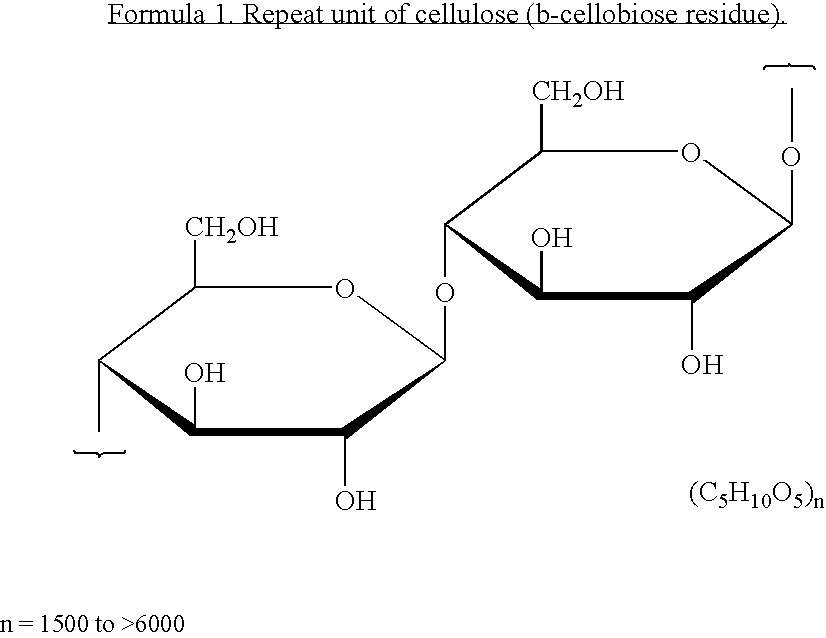Treatment of natural polymer based materials and the products based thereon
a technology of natural polymer and products, applied in the field of natural polymer based materials and the products based thereon, can solve the problems of poor material performance, difficult wet and bonding of vegetable products based on natural polymers and many other problems, and achieve the effect of substantially improving the bonding of materials to natural polymeric materials such as cellulosic materials
- Summary
- Abstract
- Description
- Claims
- Application Information
AI Technical Summary
Benefits of technology
Problems solved by technology
Method used
Image
Examples
example 2
[0201]The method of Example 1 was repeated using corona discharge or UV radiation or ozone in place of flame oxidation. The condition for corona discharge treatment were as follows:
[0202]
Power Output1 kw maximumFrequency13-30 kZ2Speed0.1 to 70 m / min
[0203]The distance between the substrate and electrode was 2.5 mm.
[0204]UV radiation and ozone exposure were achieved by the use of a UV source (Fusion UV), and were used instead of corona treatment. The treatment speed for UV and ozone treatment was 2 m / minute.
example 3
[0205]This example explains the influence of surface modification of various types of wood species on surface properties, such as components of surface energy (dispersive and polar) the latter being relevant to the quality of adhesion. The influence of these treatments on the retention of surface properties upon storage for a period of two weeks under various storage conditions is also explained.
[0206]Types of wood species:[0207]pine[0208]mountain ash[0209]oak[0210]meranti
[0211]Treatments[0212]1. As received[0213]2. Flame only[0214]3. 1% NaOH leaching at 80° C.[0215]4. 1% NaoH leaching at 80° C. and Flame[0216]5. Treatment (2)+0.25% PEI (Mw=50,000)[0217]6. Treatment (3)+0.25% PEI (Mw=50,000)[0218]7. Treatment (4)+0.25% PEI (Mw=50,000).[0219]PEI was used as water-based solution.
[0220]
TABLE ASurface energy of wood in relation to various types of surfacetreatment [γP] polar component; [γ TOTAL]: total surface energySurface Energy [mJ / m2) FreshlyStorageTreated(2 Weeks / TimberTreatmentWoo...
example 4
[0228]In this example the influence of wood surface treatment type on the quality of paint adhesion is demonstrated.
[0229]Types of Wood:[0230]pine[0231]mountain ash
[0232]Paint: acrylic “Ponderose Prime”
[0233]Treatment types:[0234]1. Untreated[0235]2. Flame only[0236]3. Flame+0.25% PEI (Mw=50,000)[0237]4. Leaching (1% NaOH)+Flame+0.25% PEI[0238]PEI was used as water-based solution.
[0239]To determine the quality of surface treatment on paint adhesion, the wood samples were painted subsequent to treatments 1 to 4. Paint adhesion was assessed in accordance with ASTM D 4541-89 standby adhesive bonding of aluminium dolly to painted surface, and pull-off test. The strength of adhesion [Mpa] and [%] of cohesive wood failure (% CF) were assessed. Paint adhesion was assessed in dry condition and after artificial simulated by aging achieved through by 8 days immersion in 60° C. water.
[0240]
TABLE BPaint adhesion quality upon various types of surface treatmentSurface Energy [mJ / m2]DryDays inAdhe...
PUM
| Property | Measurement | Unit |
|---|---|---|
| temperature | aaaaa | aaaaa |
| temperature | aaaaa | aaaaa |
| time | aaaaa | aaaaa |
Abstract
Description
Claims
Application Information
 Login to View More
Login to View More - R&D
- Intellectual Property
- Life Sciences
- Materials
- Tech Scout
- Unparalleled Data Quality
- Higher Quality Content
- 60% Fewer Hallucinations
Browse by: Latest US Patents, China's latest patents, Technical Efficacy Thesaurus, Application Domain, Technology Topic, Popular Technical Reports.
© 2025 PatSnap. All rights reserved.Legal|Privacy policy|Modern Slavery Act Transparency Statement|Sitemap|About US| Contact US: help@patsnap.com

